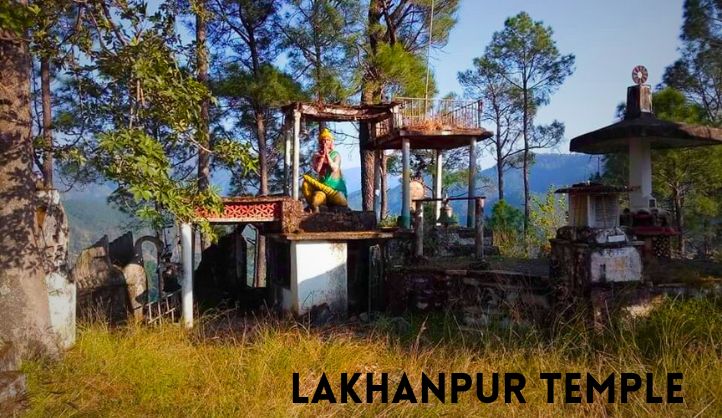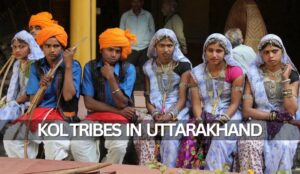In the lush green hills of Uttarakhand, amidst the tranquil surroundings of Chaukhutia village, lies a sacred haven that whispers stories of faith and folklore. Welcome to Lakhanpur Temple, a place where spirituality dances with nature, and history breathes life into the present. Join me on a journey through the mystical allure of Lakhanpur Temple as we delve into its origins, significance, and spiritual ambiance that continues to captivate pilgrims and wanderers alike.
Origins and Legends
Lakhanpur Temple is steeped in mythology and legend, its origins dating back centuries. According to local folklore, the temple is dedicated to Lord Shiva, the supreme deity in Hinduism, and holds immense religious significance for devotees. The name “Lakhanpur” is believed to be derived from the name of Lord Ram’s brother, Lakshman, adding a touch of divine connection to the temple’s identity.
Legend has it that the temple was established by a devout sage who was drawn to the serene beauty of Chaukhutia and the spiritual energy that permeated the land. Guided by visions and divine inspiration, the sage erected the temple as a sanctuary for seekers of truth and spiritual seekers.
How to reach
By Air
The nearest airport to Lakhanpur Temple is Pantnagar Airport (PGH), located approximately 80 kilometers away. From the airport, you can hire a taxi or take a bus to Chakhutia village.
By Train
The nearest railway station to Lakhanpur Temple is Kathgodam Railway Station (KGM), situated around 70 kilometers away. From Kathgodam Railway Station, you can hire a taxi or take a bus to Chakhutia village.
By Road
Chakhutia village is well-connected to major cities and towns in Uttarakhand by road. You can reach Chakhutia by private car, taxi, or state-run bus. The village is approximately 12 kilometers from Almora, and the journey takes around 30 minutes by road. From Almora, you can hire a taxi or take a local bus to reach Chakhutia village.
Architectural Splendor
Nestled amidst verdant landscapes, Lakhanpur Temple boasts a simple yet elegant architectural style typical of many Hindu temples in the region. The temple’s facade is adorned with intricate carvings and sculptures depicting various mythological figures and motifs, reflecting the rich cultural heritage of the area.
The sanctum sanctorum houses the main deity, Lord Shiva, in the form of a sacred lingam, a symbol of cosmic energy and creation. Devotees offer prayers, perform rituals, and seek blessings from the deity, believing in the transformative power of divine grace.
Spiritual Significance
For centuries, the Lakhanpur Temple has been a revered pilgrimage site, drawing devotees from far and wide to seek solace, divine intervention, and spiritual enlightenment. The tranquil ambiance of the temple, coupled with its natural surroundings, creates an atmosphere conducive to introspection, meditation, and communion with the divine.
Pilgrims embark on a spiritual journey to Lakhanpur Temple, seeking to cleanse their souls, seek blessings for their endeavors, and connect with the sacred essence of the universe. The temple serves as a gateway to transcendental experiences, where the boundaries between the material and the spiritual blur, and seekers embark on a quest for higher truths.
Festivals and Celebrations
Throughout the year, Lakhanpur Temple comes alive with vibrant festivities and religious celebrations that reflect the cultural tapestry of Uttarakhand. Maha Shivaratri, the Great Night of Shiva, holds special significance at the temple, as devotees gather to worship Lord Shiva and seek his blessings for prosperity and spiritual upliftment.
During festivals, the temple resonates with the sounds of devotional hymns, the fragrance of incense, and the fervent prayers of devotees, creating an atmosphere charged with divine energy and devotion. These celebrations not only foster a sense of community and unity among pilgrims but also serve as a reminder of the enduring legacy of faith and tradition.
Preserving Heritage
As custodians of cultural heritage, the caretakers of Lakhanpur Temple are tasked with preserving its sanctity and significance for future generations while also adapting to the evolving needs of modern pilgrims. Efforts are underway to enhance the temple infrastructure, improve facilities for visitors, and promote sustainable tourism practices that respect the environment and the local community.
At the same time, initiatives are being launched to raise awareness about the historical and cultural importance of Lakhanpur Temple, both among locals and tourists. Through educational programs, cultural events, and heritage conservation projects, stakeholders aim to ensure that the legacy of the temple endures for centuries to come.
Nearby places to explore
Binsar Wildlife Sanctuary
Located a short distance from Lakhanpur Temple, Binsar Wildlife Sanctuary is a haven for nature lovers and wildlife enthusiasts. Spread over an area of 47 square kilometers, the sanctuary is home to a diverse range of flora and fauna, including oak, rhododendron, leopard, Himalayan black bear, and more. Visitors can enjoy nature walks, birdwatching, and panoramic views of the Himalayas from the Binsar Zero Point.
Jageshwar Temples
Journey back in time to explore the ancient temples of Jageshwar, a sacred site dedicated to Lord Shiva. Situated amidst deodar forests, Jageshwar is home to a cluster of over 100 stone temples dating back to the 9th to 13th centuries. The intricate carvings and architectural splendor of these temples offer a glimpse into the region’s rich cultural heritage and religious significance.
Bageshwar
Immerse yourself in the spiritual ambiance of Bageshwar, a historic town located at the confluence of the Sarayu and Gomti rivers. Known for its sacred temples and scenic beauty, Bageshwar is a popular pilgrimage destination for Hindus. Visit the Baijnath Temple, dedicated to Lord Shiva, and explore the vibrant markets and cultural heritage of the town.
Almora
Discover the charm of Almora, a picturesque hill station nestled in the Kumaon region of Uttarakhand. Surrounded by pine and oak forests, Almora offers panoramic views of the Himalayas and the valley below. Explore the ancient temples, colonial-era buildings, and vibrant bazaars of Almora, and indulge in trekking, nature walks, and adventure activities in the surrounding areas.
Kausani
Experience the tranquility of Kausani, often referred to as the “Switzerland of India,” for its breathtaking views of the Himalayan peaks. Situated atop a ridge, Kausani offers panoramic vistas of Nanda Devi, Trishul, and Panchachuli peaks. Visit the Anasakti Ashram, where Mahatma Gandhi once stayed, and soak in the natural beauty and serenity of this Himalayan retreat.
Mukteshwar
Embark on a journey to Mukteshwar, a scenic hill town known for its apple orchards, dense forests, and panoramic views of the snow-capped peaks. Explore the Mukteshwar Temple, dedicated to Lord Shiva, and enjoy trekking camping, and adventure sports in the surrounding wilderness. Don’t miss the sunrise and sunset views from the picturesque viewpoints dotted around Mukteshwar.
Chitai Temple
Pay a visit to the Chitai Temple, dedicated to Lord Golu Devta, the deity known for granting wishes and fulfilling prayers. The temple is famous for its unique tradition of hanging bells as offerings, symbolizing the fulfillment of devotees’ desires. Experience the mystical ambiance of Chitai Temple and witness the age-old customs and rituals practiced by locals.
Ranikhet
Explore the idyllic hill town of Ranikhet, renowned for its scenic beauty, lush greenery, and colonial-era charm. Visit the Jhula Devi Temple, adorned with numerous bells, and enjoy leisurely walks amidst pine forests and orchards. Ranikhet also offers opportunities for golfing, birdwatching, and nature exploration in its pristine surroundings.
Chaukori
Revel in the tranquility of Chaukori, a hidden gem nestled in the Himalayan foothills, known for its panoramic views of the snow-capped peaks and verdant valleys. Explore the tea gardens, trekking trails, and ancient temples of Chaukori, and witness the mesmerizing beauty of sunrise and sunset over the Himalayas from its vantage points.
Conclusion
In a fast-paced world fraught with distractions and uncertainties, places like Lakhanpur Temple serve as sanctuaries of solace and spiritual refuge. Here, amidst the timeless beauty of nature and the divine presence of Lord Shiva, pilgrims embark on a journey of self-discovery, seeking answers to life’s deepest mysteries and finding solace in the embrace of the divine.
FAQs about Lakhanpur Temple
Where is Lakhanpur Temple located?
Lakhanpur Temple is situated in the serene surroundings of Chaukhutia village in the state of Uttarakhand, India. The village is nestled amidst lush green hills, offering a picturesque backdrop for the temple.
Who is the main deity worshipped at Lakhanpur Temple?
The main deity worshipped at Lakhanpur Temple is Lord Shiva, the supreme deity in Hinduism. The deity is represented in the form of a sacred lingam, symbolizing cosmic energy and creation.
What is the significance of Lakhanpur Temple?
Lakhanpur Temple holds immense religious significance for devotees, serving as a sanctuary for seekers of truth and spiritual enlightenment. The tranquil ambiance of the temple, coupled with its natural surroundings, creates an atmosphere conducive to meditation, introspection, and communion with the divine.
Are there any festivals celebrated at Lakhanpur Temple?
Yes, several festivals are celebrated at Lakhanpur Temple throughout the year, with Maha Shivaratri being the most prominent. During festivals, devotees gather to worship Lord Shiva, offer prayers, and seek his blessings for prosperity and spiritual upliftment.
What are the architectural features of Lakhanpur Temple?
Lakhanpur Temple boasts a simple yet elegant architectural style typical of many Hindu temples in the region. The facade is adorned with intricate carvings and sculptures depicting various mythological figures and motifs, reflecting the rich cultural heritage of the area.
Is there accommodation available near Lakhanpur Temple?
Yes, there are accommodations available in the nearby Chaukhutia village for pilgrims and tourists visiting Lakhanpur Temple. These accommodations range from guesthouses and lodges to homestays, offering comfortable lodging options for visitors.





